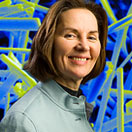News
Takeuchi focuses on power sources
-
 Print
Print -
 Comments
Comments
-

“I believe we will see an increase in the level of attention paid to batteries and energy-storage devices in this administration as we move forward.”
A UB faculty member who has garnered more than 140 patents for power sources for tiny biomedical devices now is working to develop batteries that could power much larger devices, such as electric vehicles.
Esther Takeuchi, Greatbatch Professor in Power Sources Research, School of Engineering and Applied Sciences, invented the tiny batteries that have helped make implantable cardiac defibrillators and other medical devices a life-saving reality.
She now is applying that expertise to power-source issues key to developing electric vehicles and alternative energy storage devices.
“The fundamental work we do is directly applicable to EV (electric vehicle) work,” said Takeuchi, who teaches “Battery Function and Use,” a senior-level undergraduate course at UB.
“We are looking at properties such as improving battery rechargeability and decreasing battery weight while boosting power, both of which are absolutely necessary to the development of electric vehicles and energy storage devices,” she said.
One innovative approach her lab is taking involves developing nanostructured metal oxide materials for use in batteries using lightweight, supported structures, which still have very high power density.
“The idea is that by increasing the number of sites that transfer electrons, the electroactive sites on the cathode, we can increase the amount of electron and ion transfer while reducing the distances those electrons or ions have to travel,” said Takeuchi. “This allows for a faster response and higher power density.”
Takeuchi is exploring ways to address the key challenges common to developing the next generation of energy-storage devices for a broad range of applications.
“We are looking at ways to address issues of power, stability versus temperature, voltage, lifetime and, of course, the biggest challenge: cost,” she said.
She noted that part of the challenge of adapting batteries to electric vehicles is that they will require not just one battery, but many.
“The challenge there is to develop a low-cost electronic system capable of efficiently coordinating and controlling them,” she said.
In addition to the importance of developing batteries for electric vehicles and plug-in hybrids, Takeuchi pointed out that a broad range of novel technologies and applications require better power sources.
“There’s no doubt that energy storage is critical to the further development of alternative forms of power, such as solar and wind, which are intermittent energy sources,” she said. “Therefore, they need a way to store the energy that they generate.”
Some applications for homeland security that rely on sensors also will require more efficient and portable power sources, which Takeuchi said already are generating additional interest from federal funding agencies.
“I believe we will see an increase in the level of attention paid to batteries and energy-storage devices in this administration as we move forward,” she said.
As part of the UB initiative in biomedical engineering, Takeuchi and her colleagues also are working with researchers at the School of Medicine and Biomedical Sciences to explore how new concepts for medical devices they developed could be powered.
Takeuchi is a member of the faculty advisory board of the strategic strength in Integrated Nanostructured Systems identified in the UB 2020 planning process, which brings together researchers in the life sciences, medicine and engineering to promote interdisciplinary advancements.

Reader Comments